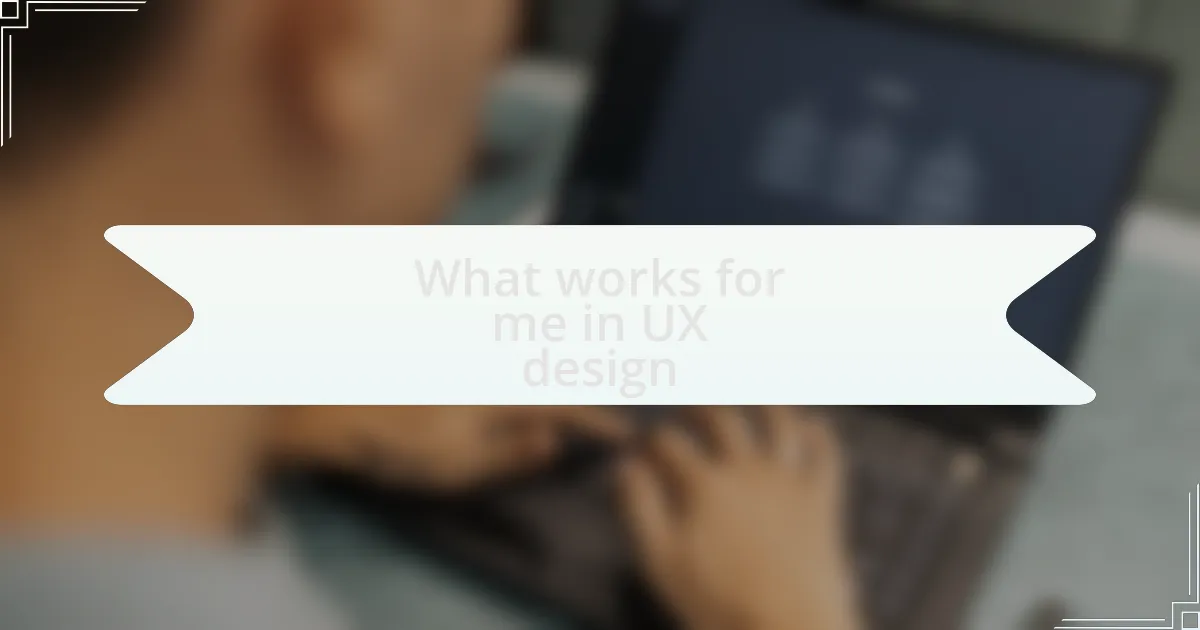Key takeaways:
- Empathy in UX design is crucial; understanding user experiences leads to more intuitive designs.
- Consistency and simplicity significantly enhance user satisfaction and overall experience.
- Collaboration and feedback are essential for creating a shared vision and improving design outcomes.
- Iteration and flexibility in design are necessary to adapt to real user needs and experiences.
Author: Oliver Bennett
Bio: Oliver Bennett is an acclaimed author known for his gripping thrillers and thought-provoking literary fiction. With a background in journalism, he weaves intricate plots that delve into the complexities of human nature and societal issues. His work has been featured in numerous literary publications, earning him a loyal readership and multiple awards. Oliver resides in Portland, Oregon, where he draws inspiration from the vibrant local culture and stunning landscapes. In addition to writing, he enjoys hiking, cooking, and exploring the art scene.
Understanding UX Design Principles
Understanding UX design principles is essential for creating products that users genuinely enjoy. I remember the first time I received user feedback on a project I worked on; it was eye-opening. The small details I thought were unimportant turned out to significantly impact user satisfaction.
One principle that stands out to me is consistency. I once redesigned a site that had conflicting color schemes between pages. After aligning these elements, users reported feeling more at ease navigating the site. It made me wonder how many other platforms overlook such an easy fix that can enhance overall user experience.
Another core principle is empathy. I strive to put myself in the users’ shoes, and it has transformed my design approach. When I used to focus solely on aesthetics, I realized I was missing the mark. Now, I ask myself, “How would I feel if I were using this feature?” This question often leads to insights that create a more intuitive design.
Tools and Techniques I Use
When it comes to tools, I rely heavily on Figma for my design work. Its collaborative features have made a noticeable difference in my workflow. I vividly remember a project where my team and I worked together in real-time, making revisions on the fly. It felt almost like we were crafting the design as a single entity, which was incredibly satisfying.
In terms of techniques, I find user journey mapping invaluable. One time, while working on an e-commerce site, creating a visual path of user interactions illuminated pain points I hadn’t considered. It intrigued me how much clarity that simple technique brought to the project. Are we ever truly aware of the journey our users take until we break it down visually?
Additionally, I frequently conduct usability testing to gather direct feedback from real users. I once hosted a session where participants voiced their frustrations with a product I thought was straightforward. Their candid feedback was a moment of humility and revelation. Each session not only uncovers issues but also inspires design improvements I wouldn’t have thought of otherwise. Isn’t it fascinating how users can guide us toward a more effective solution?
My Preferred UX Design Process
Gathering insights from users is a pivotal part of my UX design process. I remember a time when I facilitated a workshop with a diverse group representing our target audience. Seeing their expressions as they interacted with prototypes was enlightening. It reminded me that design isn’t just about aesthetics; it’s about behavior and emotions. Have you ever realized that a user’s experience can shift dramatically just from a tweak in design?
Following these insights, I prioritize creating low-fidelity wireframes before moving into more detailed designs. There’s something liberating about sketching out ideas without getting bogged down in specifics. One particular instance sticks with me: I sketched out a flow for a complex feature in mere minutes, which sparked a vibrant discussion among team members. It was a great reminder that sometimes the rawness of a concept can spark innovation more than polished iterations. Why do we often get trapped in striving for perfection so early on?
As my designs develop, I continually solicit feedback from stakeholders. This process feels like a dialogue rather than a monologue. I distinctly recall presenting a design that I was proud of, only to receive constructive criticism that shifted my perspective entirely. Engaging others not only refines the design but also fosters a shared vision. Don’t you think collaboration can lead to outcomes that go beyond our initial imagination?
Lessons Learned in UX Design
Gathering insights from users has taught me that empathy is at the heart of effective UX design. I vividly recall a project where I conducted interviews with users who struggled with a product. Their stories, filled with frustration and hope, highlighted areas I hadn’t even considered. It made me wonder: how often do we miss these pivotal moments simply because we forget to listen?
One of the biggest lessons for me has been the importance of iteration and flexibility. I remember presenting a prototype that I thought was flawless, only to discover that it didn’t meet some users’ needs at all. That experience was humbling and reinforced my belief that design needs to adapt based on real interactions. Doesn’t it strike you as fascinating how what we envision can often differ from the reality of user experiences?
Additionally, I’ve learned the value of simplicity in design. There was a time when I wanted to showcase everything a feature could do, but I ended up overwhelming users. A mentor advised me to focus on what truly mattered. That moment transformed my approach. I now ask myself: how can I strip down complexity while still delivering value? This constant pursuit of clarity has led to designs that not only resonate with users but also enhance their journey.

Leave a Reply